Two hypercars in the wild, far from their normal environs of Monaco or Miami Beach. And anything but lost.
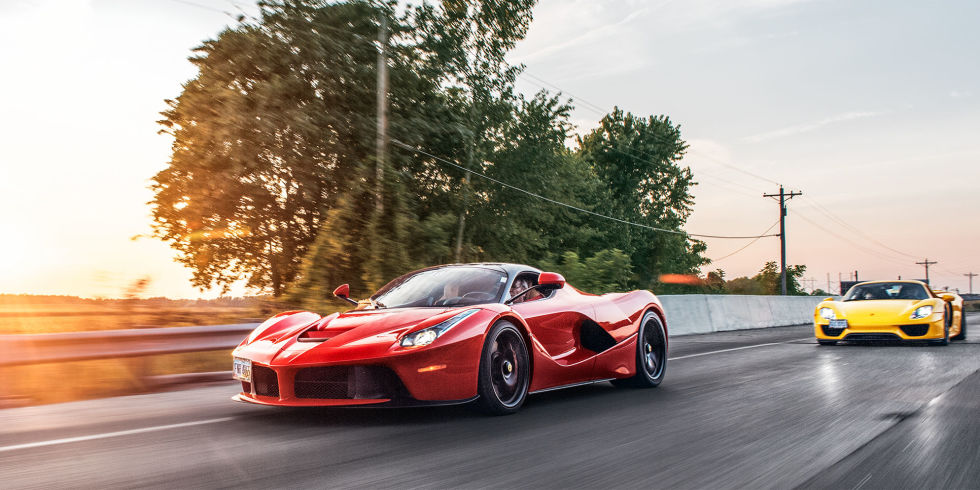
THEY SAY THE FUTURE AIN’T WHAT IT USED to be. Maybe that explains why the oldest traffic light in America looks like something out of The Jetsons. It’s the size of a 55-gallon drum, with four apertures, each shaped like an alien eye. A phonograph motor turns an internal mechanism that cycles lenses in each eye, red to green. From 1932 to 1982, that light directed traffic in Ashville, Ohio, population 4149.
We asked the people of Ashville to bring their light back for a one-night stand. Beneath it, we parked a 2015 Porsche 918 Spyder and a 2015 Ferrari LaFerrari—two hybrid hypercars that presage the future without ignoring the past.
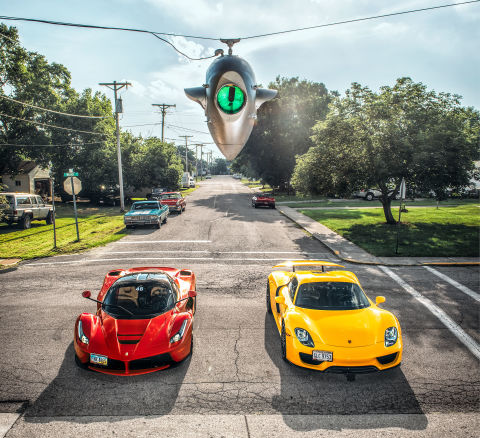
This was all part of an experiment—two of the nuttiest speed devices in history, used like actual transportation. We’ve covered these cars before, of course. We’ve driven them on manufacturer launch programs and independently, for test numbers. We’ve taken these cars to road courses and drag strips, everywhere but real life.
As it happens, we know a guy who uses both a 918 and a LaFerrari as daily drivers. Stan Ross is a retired attorney from Columbus, Ohio. He’s graced these pages in the past—editor-at-large Sam Smith drove his Le Mans–winning Porsche 962 for a story in 2015—and he allowed us to use his cars as he and his adult son, Malcolm, do. Just one caveat: A tight schedule kept us from leaving Ohio.
Like Walt Whitman, the Buckeye State contains multitudes. Winding two-lanes, sandy beaches, and a racetrack so recherché that few people know it exists. Smith and R&T’s resident Ohioan, Jack Baruth, have plenty of real-world supercar time, so we sent them for a couple of days with the 918 and LaFerrari.
One thousand, eight hundred thirty-six horsepower and three electric motors. But also two garrulous guys with lead feet. We recorded their off-the-cuff chats at each stop because we figured they’d be interesting. Turns out we were right.
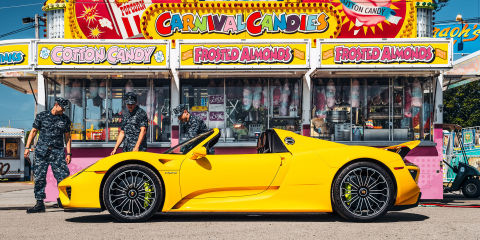
The first morning was spent in Columbus, no hoopla. Baruth and Smith went to a county fair, slogged through traffic, and just generally tried to share the cars with anyone who asked. At the fair’s midway, just before lunch, watching the photographer set up a shot:
Jack Baruth: [Looks at 918] The first thing I noticed was the size of it. Somehow I’d been thinking of the car as a Boxster-plus, but a Boxster feels like a toy next to this. You don’t get that in pictures.
Sam Smith: They’re both huge, right? But it’s that strange bigness of the modern supercar—not just width, like a Miura. The thick, high flanks of a modern, crashable car. In the Ferrari, the door tops come up to your chin. Stand by the 918, the fenders hit your hips.
JB: The 918’s styling—generic supercar, not Porsche DNA. Kinda-sorta Carrera GT from the B-pillar to the tops of the rear wheel arches. The LaFerrari isn’t handsome, but…
SS: Oh, come on.
JB: Uglier than the Enzo. Which is saying something. None of the modern ne plus ultra Ferraris have been handsome. Unless you see the 288 GTO as a legitimate forerunner to this car.
SS: I always kind of liked the Enzo, in a carbon-futurebug sort of way.
“The best part is just how relentlessly the 918 murders landscape. It feels more violent than the Ferrari, this never-ending wallop.”
JB: Still, the LaFerrari looks like a Ferrari. People know what it is. Remember the gas station this morning? Some grizzly old guy in a rusty F-100 rolled up to me and said, “What’s that car parked next to the Ferrari?”
SS: The 918 has a bit of H. R. Giger in it. Organic but consciously assembled. The Ferrari just looks like it was birthed. And then you put the doors up, and it’s trying to dismantle itself.
JB: You see the tub, the back of a front tire, what makes it up.
SS: Special cars seem more special when you get an obvious sense of the engineering from the curb.
JB: The 918 always looks indivisible.
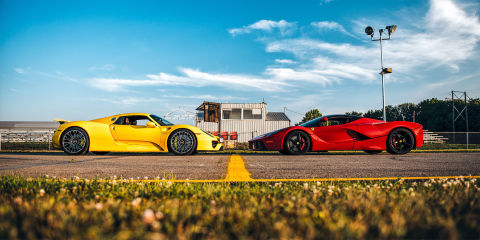
SS: Those seatbacks are indivisible. No recline, full military. After the first hour, my spine was screaming. The passenger seat reminds me of an F40: Here, this is what prototype drivers get at Le Mans. Leave the purse at home and keep your hair short.
JB: I’m six-two. I’m surprised at how well I fit. Stan said his wife won’t ride in the Porsche, and I don’t think she’s nuts. Hate to put it this way, but the car never shrinks around you. You’re always aware of its complexity. That touchscreen console is a nod to the Carrera GT, right?
SS: Yeah. It washes out in direct sunlight. Like when the car’s top is off. And if you have a 918 and it’s sunny, who leaves the roof on? I mean, the menus aren’t bad—they remind you of an iPhone, if an iPhone were impossible to read outdoors and bolted to a 3800-pound, $845,000 battery.
JB: It’s a take on the little raised center console in a Prius, right down to the miniature shifter. It’s almost like Porsche is embarrassed at the suggestion that the car has any transmission at all, so you get a little thumb-nub ColecoVision controller. That feels like it could break at any moment.
SS: In a car that cost almost seven figures.
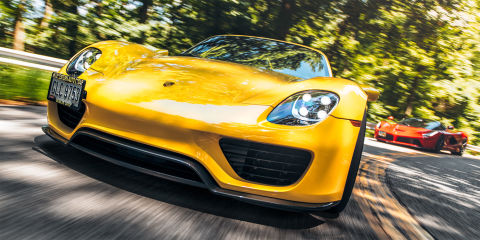
After Columbus, they headed to the Hocking Hills, in southeast Ohio. Traditional car-magazine stomping grounds: mountains, fast corners, nutty pavement. At the entry to a state park, they traded cars—Baruth climbed out of the Ferrari, and Smith exited the 918:
SS: God. The best part is just how relentlessly the 918 murders landscape. It feels more violent than the Ferrari, this never-ending wallop. The torque handoff between motors and engine is just seamless. Even on the part of the tach where your gut says the thing shouldn’t be awake.
JB: You control the behavior via this little rotary drive-mode selector. Have to say, it’s not terribly expensive-looking.
SS: Right, but be fair. [Points to the Ferrari] Those door tops have bubbles in the laminate. One airbag cover fits a little wonky. The 918’s gaps, trim, carbon, it’s all flawless. Every LaFerrari I’ve seen has had rough edges.
JB: At this price, do you want hand finish, unique and flawed and human? Or something perfect?
SS: Dunno. I like hand-varnished furniture.
JB: Malcolm told me he usually leaves the 918 in “H”— Hybrid mode. Where it behaves kind of like a Prius. The engine switches on without warning. But this, you know, it’s not a Prius four-cylinder, so when it lights off…
SS: The whole county knows it.
JB: Freaks you out, the first 20 times.
SS: Those pipes are soup cans. Straight up out of the rear deck. You could fill them with water and drown a cow. Just electric-motor whine, then YELLING LIKE A CAN-AM CAR. I went on the 918 media launch, in Europe. An engineer told me that they actually produce measurable downforce at full honk. Just blowing air into air.
JB: Route 374, halfway up the road, I twisted the knob to “S.” Sport Hybrid mode, direct correlation between acceleration and revs—they rise like the engine has a flywheel made of air. “You have to convince yourself to keep it floored,” Malcolm said, laconically. I had to give the man credit for not throwing himself out of the passenger door.
SS: He tell you that he used to test 1980s Indy cars? He told me, “I really like getting good fuel economy in this car. I’ll drive it to maximize economy.” I’d have to leave it on full yell, all the time.
JB: You can do 70 mph on a back road with the engine off. It’s hugely impressive, but the cynic in me says that it’s the most expensive way in the world to pretend you’re driving a Tesla Roadster.
SS: You can’t knock a plug-in hybrid for having an electric mode.
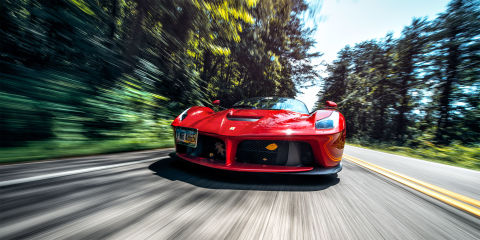
JB: Compare it with the LaFerrari’s drivetrain, though. Transparency. Stan likes that car better. He also pointed out that the swing-up doors make it remarkably easy to get in and out of. My only issue is the high sill. Roomy cockpit, like a 488, though the trunk is useless and the 918’s isn’t.
S: The line he gave me was basically, “When we take a trip in the Ferrari, we leave the owner’s manual at home. Doubles the trunk space.” Which really only holds the manual and that huge wheel-nut socket. What happens on the road—stuff just rattles around on those carbon floors?
JB: Exposed carbon is a big part of both cars. Right now it’s great, but I have to think that, in the long run, it’ll look horribly dated. Like making a whole interior of ivory Bakelite in 1938.
SS: It’s always so weird, the fashion aspect of a supercar. Look at the 1980s tech prove-outs: Ferrari F40 and Porsche 959. The F40 now seems a period piece—bloodthirsty and awesome but compromised. The cockpit doesn’t fit anybody; it’s noisy and hot and a pain at anything less than full blitz.
“The Ferrari didn’t have to be as good as it is. Every LaF was sold when it was built. It could have easily been this lash-up, an Enzo with battery-powered front wheels.”
JB: The 959 was certainly more prescient.
SS: Quiet, comfy, looked halfway normal. Not better, but less fashionable and smarter. Turbos and a digital all-wheel-drive chassis; you can buy a new Focus with that. The 959 was more usable and important; the F40 was just itself.
JB: Maybe the shoe’s on the other foot. Next to a 918, the LaFerrari is much more of a regular car. “Regular” in the sense that you could go directly from a 488 or F12 into this car, and you’d feel immediately at home. The 918 never stops beating you over the head with its uniquity.
SS: The noise, the zillion drive modes, those seats. That red “full attack” boost button on the wheel.
JB: The hybrid stuff happens behind the scenes. You could drive and enjoy the Ferrari for a lifetime and never know it was a hybrid. You’d just think it was some kind of eight-liter, quad-turbo V-12 with magical anti-lag technology or something. But it revs and sounds and behaves like a traditional Ferrari.
SS: It’s a nice cross between the big cars and the little ones, the F12s and the 488s. Next to a 488, it doesn’t seem as caffeinated, less of a hummingbird. I’m sure the LaFerrari dances when you get it up on plane, but that’s got nothing to do with public roads—the “cheaper” Ferraris are better for that. It’s built for different work.
JB: You can’t reach the limits of this kind of car on any back road.
SS: It’d be criminal.
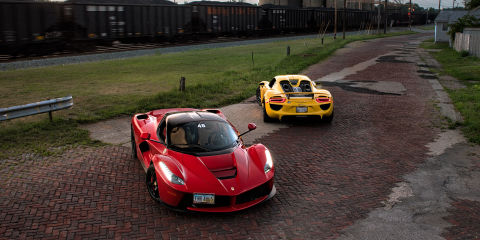
It’s easy to get lost in the Hockings; the boys spent a long afternoon in the hills before heading back to Columbus, in traffic. That evening, over drinks, the conversation kept landing on the Ferrari:
JB: The power there—it’s just instant. Omnipresent. You see rich kids turning the manettino to Race in YouTube videos. Heaven help the guy who does that on the street. Even running along in sixth gear at 60, there’s supercar power, no downshifting.
SS: More traditional delivery than the 918, too. Peakier. The engine is baritone—not as animal as most Ferrari V-12s, just gruff and barky. I remember the F12 being more operatic. The steering is the same butter, though—creamy, hydraulic, somehow both removed and pin-sharp. A dying art.
JB: The Porsche is electrically assisted. Like almost every modern car.
SS: One of the few science projects they didn’t solve for. It’s fine, but a GT3 tells you more about the front tires.
JB: The problem for me is that I think both cars would be better without the hybrid components. My first miles in the LaF, the car would lurch and buck for what seemed like no reason.
SS: Same here. Stan reached out and switched off the auto start/stop for me. That button on the roof console. Brake feel went from yuck to decent. The 918 has Porsche-perfect brakes—microscopic travel, great bite, you can modulate just by breathing. The Ferrari feels unfinished there—wooden, like it doesn’t want your help.
JB: You drove early 918s, right? On the launch?
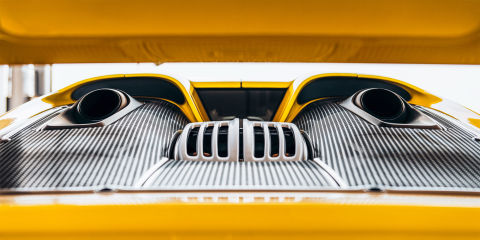
SS: Preproduction. Those cars weren’t like this—the brakes were more on-off, and the regen was odd, like the LaFerrari. The sold car is way different. The Germans, iterating a problem into vapor.
JB: And yet Porsche couldn’t iterate passion into the 918. The LaF has it in spades.
SS: Right? But you drive the LaF enough, it slips into being normal. That weird thing where a car just kind of disappears underneath you.
JB: Again, the transparency.
SS: Which is funny, because that doesn’t happen a lot with supercars. You know the Porsche is shuttling torque and working electric motors and brakes and steering boost because it shoves that stuff in your face—nutty front grip, silly traction, flattering balance when you’re in the throttle. And a sense that it’s constantly out-thinking you. You’re always aware of the math beneath the surface.

The next morning, over coffee, before heading into local farmland for photography:
JB: [Turns to Smith] Just occurred to me: You know what’s impressive? The Ferrari didn’t have to be as good as it is. Every LaF was sold when it was built. It could have easily been this junky lash-up, an Enzo with battery-powered front wheels. Instead, it really works: as a daily driver, a performance car, a superbike killer for freeway rolls. People don’t give Porsche the same slack, and they shouldn’t. The 918 had to be sorted.
SS: The Ferrari is an orchestra. You focus on the whole, not parts. These cars are both technology suites, but the face presented to the driver is different.
JB: The message you get from the 918 is, “Hey, look at this hypercar with all the tech.” The LaFerrari is, “You’re in a Ferrari.” Maybe that’s because the Ferrari brand is inherently more special, stronger. At least in 2016.

SS: Well, there’s nothing to dilute it—no SUVs, sedans. They sell, what, under 10,000 cars a year? But it’s an interesting dichotomy. In a few decades, one of these cars will seem like an exercise—function stack-up to push a boundary. The other’s going to be seen as existing for the sake of itself. Ferrari has only ever built special cars. Porsche has spent decades making practical cars. We probably shouldn’t be surprised when one builds more emotional million-dollar art and the other spits out tech genius with a little less charisma.
JB: What do you think the person buying one wants?
SS: Both? A lot of 918 owners have LaFerraris.
JB: Here’s something that tells you a little about the customer base: Malcolm is trying to get a set of Hoosier track tires for the 918. He wanted something more focused than the Michelins it ships with.
It’s a rare car, so obviously there was nothing for it immediately, off the shelf. But what fascinates me is that nobody else seems to be asking the question. There are a thousand or whatever 918s out there, and nobody’s looking for nonfactory track rubber. Is anybody actually driving them on track? More to the point, is anybody driving them at all? Or are they all sitting in garages with an expectation that they’ll appreciate? Like an F40, like the Carrera GT?
SS: Easy to guess an answer.

JB: But it’s an interesting problem to have, right? I love the fact that Stan and Malcolm use these cars. Stan drives the LaF to his office a few days a week. He takes it on road trips. Malcolm takes the 918 to Whole Foods and Mid-Ohio. They both accept that driving a million-dollar car in public makes you a public figure, better or worse.
SS: I checked yesterday: The 918 has 7600 miles on it. The LaFerrari has 5300. Relatively massive, but we’re at a weird place in history—these cars have a short shelf life at the top of the pyramid, even for supercars. Gas-electric hybrids in general are a stopgap. Not zero-emission, not even the step before that. They exist for a reason, but they’re only going to become less relevant.
JB: These two cars are like the Concorde—they answer a question no one is asking, in this incredibly expensive fashion.
The second afternoon was spent in and around Ashville, home of the world’s oldest stoplight. We had a cherry picker as a photo platform, and a crowd assembled. Smith and Baruth stood nearby:
SS: It was your idea to come and see this stoplight. I didn’t get it at first, but it just hit me: That light was designed by a guy looking forward. Imagining a future that never quite happened.
JB: See?
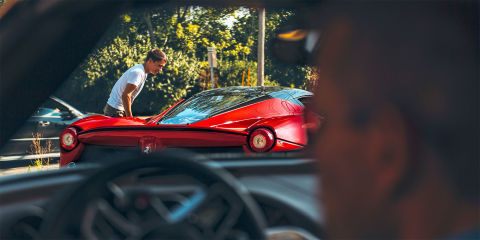
SS: I love how our image of the future is always different from what comes to pass. It’s so wonderfully optimistic—attempting to mold the new without knowing how we’ll use or need it.
JB: And yet, with cars like these, keeping the classic appeal of the form. Look at this: That crew carefully putting the light up, the cops kind of casually blocking the road, 30 or 40 people standing around watching… utterly timeless. You’d have had the same kind of people, saying the same things, on this street when the first horseless carriage hit town.
SS: Or the first Corvette.
JB: It’s obvious that the community here—they all know each other well. The cars are just pretext to assemble and chat and swap stories. And it reminds you that cars like this are really only valuable for the human interest. In this context, does it matter if the Ferrari has a V-12 or a hydrogen power cell? It’s like the circus. Everybody goes to see the elephant, and it doesn’t matter whether it’s African or Asian.
SS: They’re both based on this kind of bogus idea that there’s going to be room in the future for 900-hp, two-ton, two-seat cars because… what? Because they have electric motors? That traffic light was designed to look futuristic. A modern stoplight is completely unromantic. It just works.
JB: Whatever design there is, it’s totally based on function.
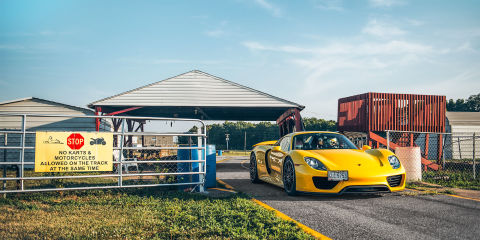
When this story was being planned, a track visit seemed obvious. Unfortunately, Ohio’s storied road courses— Nelson Ledges and Mid-Ohio—were unavailable, so we wrapped up at a kart track in Circleville, near Columbus. Half for a funny photo, half because Baruth knew the owner, and… why not?
SS: When you said you wanted to come here, I thought you were kidding.
JB: Seven-tenths of a mile, 10 turns. Could only exist in Ohio. There’s a locked gate, but you can just drive around. It’s on the honor system. My seven-year-old son practices here with his Top Kart, which is why I know it exists. And now, somehow, I’ve driven a 918 at this place. [Laughs.]
SS: Lap record or we are no longer friends.
JB: Too big, too rapid. Didn’t matter. It was a chance to break the tires loose and see that the fundamental balance is pretty solid. I don’t know if it could beat a Cayman in an SCCA autocross. It’s just so wide, and it takes a bit of sawing in tight transitions. If there are flaws in the handling, they’re probably hidden another hundred miles per hour away.
SS: On the media launch, they stuck us on a MotoGP test track in Spain. Camber change and fast corners. I have this vivid memory of sliding the car over a blind fourth-gear hill, thinking, “Who knew?” Like three laps into the day, just amazed at how quickly the 918 got friendly.
JB: Stan told you how he bought the cars, right?
SS: Ferrari asked him to write a multipage autobiography! Just to apply for purchase. Said he bought the 918—walked into a dealer, boom—because he thought they wouldn’t let him have the Ferrari.
JB: Worse problems to have. He told me he’s been buying Ferraris for 40 years. The first one was used, a decade old. But he’s probably one of the company’s more seasoned customers. He’s got a lot of racetrack experience, has owned a lot of race cars. His perspective on Ferrari is so different from that of, say, an oil-rich sheikh or the new-wealth oligarchy in the former Eastern Bloc. The prestige doesn’t seem to matter much.

SS: You have to wonder how many LaFerraris that crowd turned into one-off special wishes. Giraffe-pelt floor mats, paint-to-sample ashtrays, whatever. That never see daylight.
JB: I love that we did this here. In Los Angeles, you see these cars run by people who tint the windows and scowl if you look at them. That whole aristocratic attitude where it’s death to touch the duke’s horse. That wouldn’t fly in Ohio. Everybody thinks they’re just as good as you are, and they’ll come right up and talk to you.
In the end, I think Porsche and Ferrari need a percentage of buyers who actually use the cars. It keeps them honest. There will always be a market for half-finished, high-priced junk that some prince can keep in his living room. But the prestige attached to those marques is dependent on keeping the respect of the old-school customers.
SS: If you can’t keep doing business with those guys, then you’re basically Louis Vuitton selling wheeled luggage.
JB: Which is why supercars might be designed in Modena, tested in Stuttgart, and sold in Riyadh, but they still need to cut the mustard in Ohio.
SS: Mighty bold talk from a man who lives in Columbus.
JB: Technically, the town of Powell.
SS: Didn’t we drive past it at one point?
JB: Close. Couple miles away. But I bet the local sheriff heard the 918.



Leave a Reply
Want to join the discussion?Feel free to contribute!